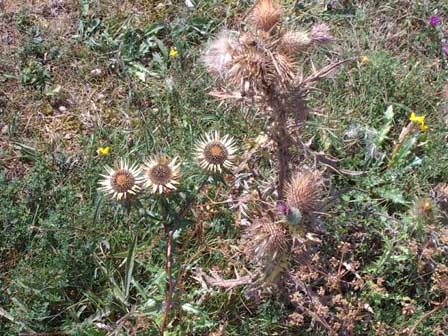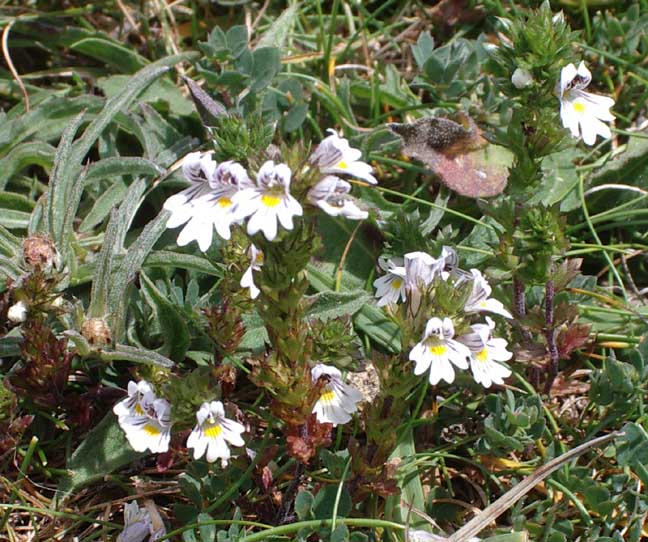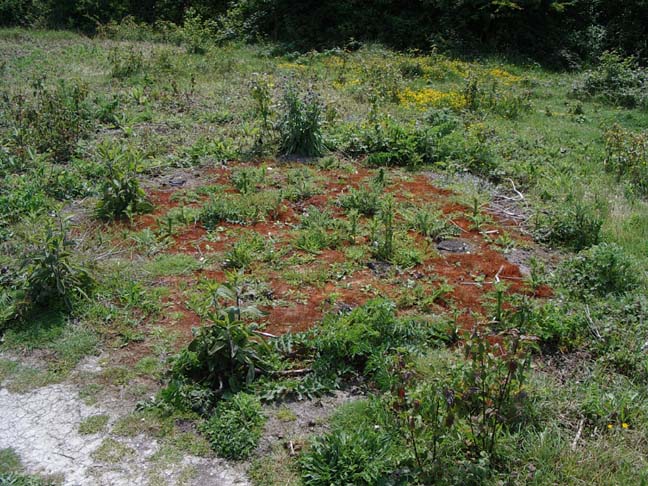 The
Triangle (Mill Hill)
The
Triangle (Mill Hill) The
Triangle (Mill Hill)
The
Triangle (Mill Hill)15
December 2003
Small
areas of the scrub on the middle slopes in the north-east corner have been
cleared of vegetation including the instrusive Dogwood
in the area I have christened as the Triangle. The amount of clearance
could be compared to previous years, creating glades that have previously
been favoured by Common Blue Butterflies.
The
red hues in the photograph above come from the low sun settling over the
horizon as dusk approached.
 7
September 2003
7
September 2003
Just
two female Meadow Brown Butterflies were
fluttering about. White Campion
was seen in the area of the patch, and I had not seen
it there before.
22
August 2003
Despite
a small area in front of the seat being cleared by the South
Downs Conservation Board (SDCB), the Dogwood
encroachment is establishing itself quicker than it is being cleared. Cattle
on these gentle slopes will not make inroads into this management problem.
The small glades of four years ago (created by the West Sussex County Council
Countryside Unit) have been completely overgrown.
 |
 |
|
|
|
|
The blue butterflies were a large handful of Chalkhill Blues, mostly battered females around the leaves of the Horseshoe Vetch and a few male Common Blue Butterflies nectaring on Bird's Foot Trefoil. There were mating Small Heaths, an occasional Meadow Brown and a single Clouded Yellow Butterfly. There was little flowering botanical interest.
 20
July 2003
20
July 2003
A
Wall
Brown Butterfly patrolled the most direct
path from the car park. On the triangle itself there was at least one Chalkhill
Blue, but it was early evening and other
butterflies
would have been hiding.
11
July 2003
It
seems that the management of this area (prior to year 2000) has conserved
an area of special interest with a large number of Pyramid
Orchids, Scabious, and
most characteristically large expanses of the chalk sward parasitic and
attractive tiny plant known as the Eyebright.
There were some Stemless Thistles
in flower. There were a handful of Marbled
White Butterflies and Chalkhill
Blues, and probably Small
Skippers.
 |
 |
 |
|
|
|
|
3
July 2003
On
a humid and overcast late afternoon, I disturbed a Marbled
White Butterfly flying towards the new
flowering Scabious
and longer grasses. The
Triangle
supports and close knit community of the traditional chalkhill pasture
of small ground hugging plants, like the Eyebright.
 |
 |
 The
cleared patch seemed to support only ruderal flora.
The
cleared patch seemed to support only ruderal flora.
24
June 2003
The
Pyramid
Orchid, Anacamptis
pyramidalis, was in flower in the
triangle and there were at least a dozen, probably more than twenty amongst
the grasses.
15
June 2003
Early
afternoon on a sunny humid Sunday with butterflies
on Mill Hill but not in this area where there
was just one record of a Brimstone
near the Triangle. (This Brimstone is out
of its normal flight season. Although the possibility of an inadvertent
misidentification for a Large White was examined, this is not thought possible.)
This
prominent species had been seen in this area last year.
14
June 2003
The
Dogwood threatens to take over. The yellow was now the Bird's
Foot Trefoil that attracted the attentions
of a solitary unidentified (probably a Common
Blue) blue butterfly. The Horseshoe
Vetch has faded to inconspicuity. The Mouse-eared
Hawkweed leaves (dark green rosette leaves with white furry hairs),
Pilosella
officinarum, seem to be common, but there seems to be no sign of
the actual flowers.
2 June
2003
For
some reason the Horseshoe Vetch in
this area is running about five days later than the lower
slopes. There are tiny patches of Bird's
Foot Trefoil as well. Red-tailed
Bumblebee,
Bombus
lapidarius, were working over the Horseshoe
Vetch and a Painted
Lady Butterfly (photographed) settled
briefly.
 |
 |
 |
26
May 2003
After
some rainy and dull days, the sun came out again on the Bank Holiday Monday.
No butterflies were seen in this area. There
were more flowers and vegetation shown in the three photographs below.
 |
 |
9 May
2003
The
Horseshoe
Vetch flowers on the upper slopes later
than down lower on the Vetch
Trail. This is the first day this year
I have recorded them.
 |
 |
 |
 |
 |
 |
 |
 |
 |
 |
 |
 |
 |
 |
It
is unclear if the patch was created by conservation work or by an illegal
barbecue fire.